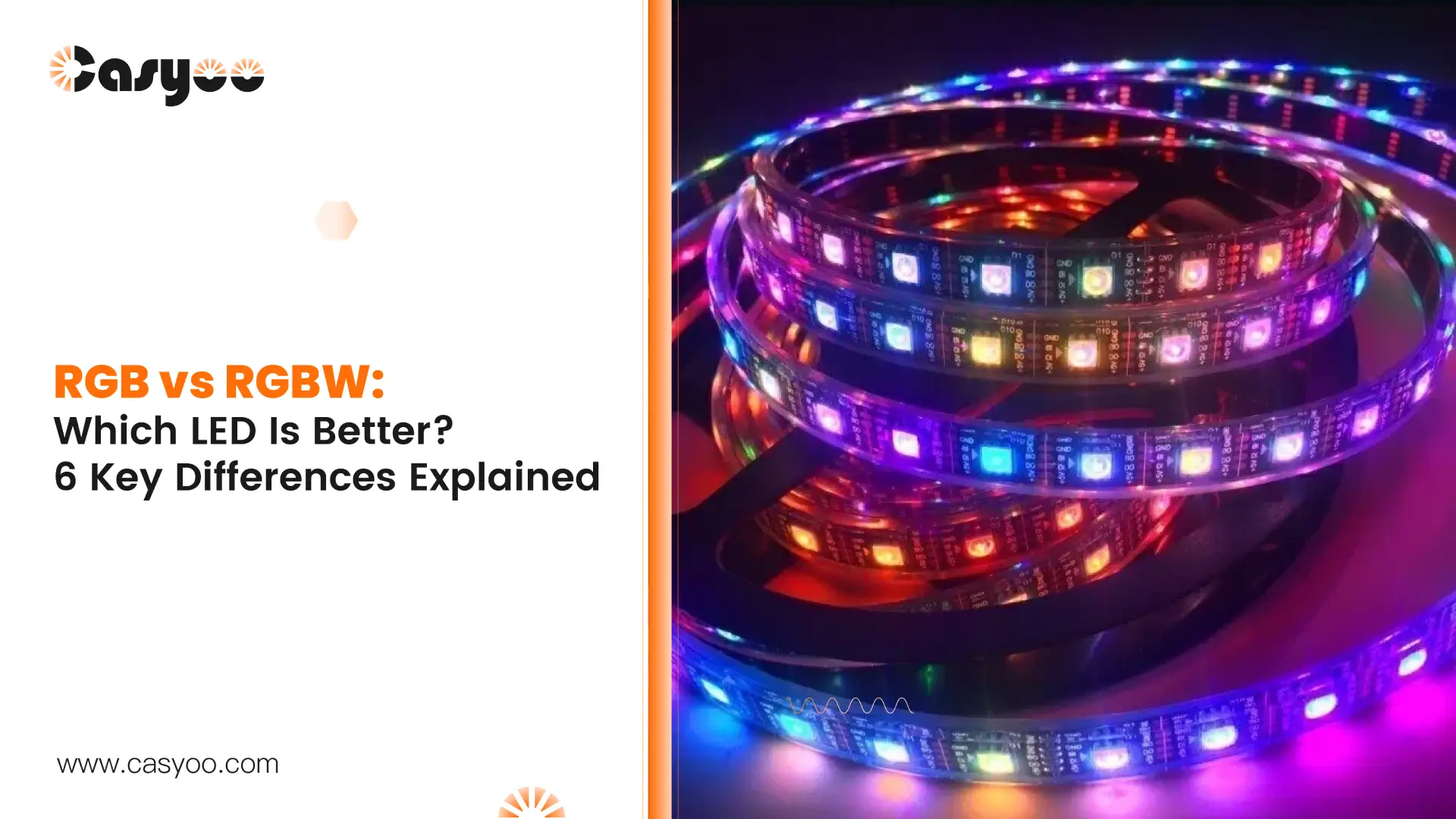RGB and RGBW LED lights are the two most common types of lights in our daily lives. Perhaps you already know that the biggest difference between the two is that RGBW can emit an additional white light. But despite of this, there are other differences between RGB and RGBW that make them suitable for different applications. Read on to find out which is better for you, RGB vs RGBW!
What do RGB and RGBW stand for?
RGB lamps have three LED chips that emit red, green, and blue primary colors. Its integrated circuit IC adjusts the current through the three RGB LED chips to change the luminous intensity of them. As the mixing ratio of the three primary colors changes accordingly, they can produce a variety of changing colors. It can synthesize all the colors within the three primary color triangles—about 16.78 million colors, including white light.
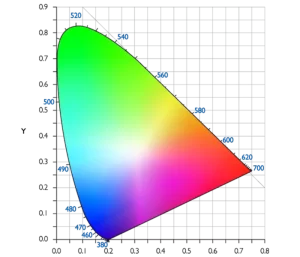
The luminous intensity of the three primary colors of light is different, even when the rated operating current is the same. In order to get white light, each color light needs different driving current. However, this current control will have flaws, and the relation between current and luminous intensity is not always linear. Therefore, sometimes it is impossible to generate perfect white light. In addition, the white light RGB lamps produce is usually dark.
RGBW lamps are thus invented, which have additional white light chips. The four-color RGBW lamp beads can provide purer and brighter white light.
RGB vs RGBW: 6 Key Differences
1. RGB and RGBW controllers
- Using remote controllers to control RGB and RGBW lights
RGBW controllers have more color channels than RGB controllers, as RGBW lights have four chips while RGB lights have three. RGBW controllers can control RGB LED strips and usually have higher rated power than RGB controllers.
The working principle of RGB and RGBW controllers is PWM signals. In RGB controllers, PWM is used to adjust the brightness of the three color channels of red, green, and blue. In RGBW controllers, PWM is used to adjust the brightness of the four color channels of red, green, blue, and white.
The input of the RGB controller usually comes from commands operated by users through buttons or knobs. These commands are processed to generate control signals. The control signal passes through the circuit to generate a PWM modulation signal, which is then sent to the RGB lamp through the output interface.
By adjusting the duty cycle of the PWM modulation signal of each channel (that is, the ratio of the switching time to the period), the controller can change the brightness of RGB lights. For instance, red can be made brighter by increasing the red channel’s duty cycle. When the PWM signal strength of the red, green, and blue channels is equal, the lamp emits white light.
- Using DMX 512 system to control RGB and RGBW lights
Each output circuit in the DMX control system can support up to 512 channels. The maximum number of devices each port can control is determined by how many channels each device occupies. Since there are 3 chips in RGB lamps and 4 chips in RGBW lamps, a DMX 512 port can connect 512/3=about 170 RGB lamp beads and 512/4=128 RGBW lamp beads, respectively.
2. Brightness
The white light of RGBW lamps can be emitted by white LED chips independently, without relying on the combination of the red, green, and blue light. This makes it emit brighter white light.
3. CRI
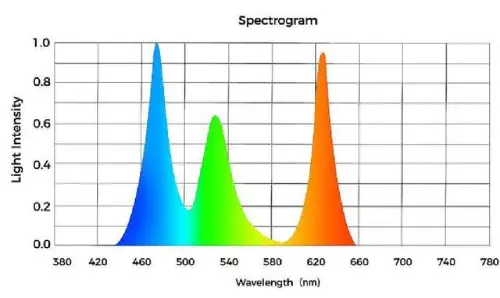
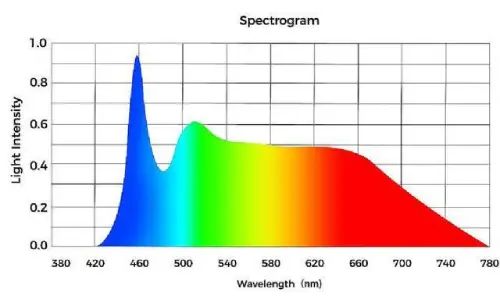
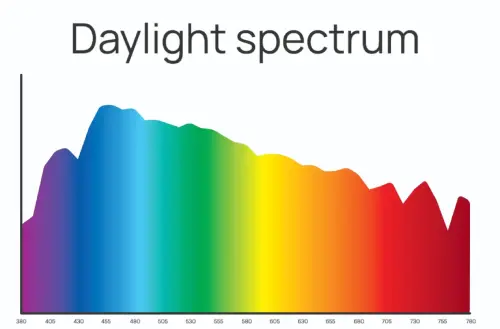
According to the spectrum above, we can find that the light produced by RGBW is more similar to daylight. This means the light can reflect what the objects really look like without causing a color cast. With the white chip, RGBW lights can also adjust the ratio of RGB three colors to produce more neutral colors, such as gray, brown, etc. In this way, the light can more accurately restore the color details of the object. The CRI of RGB lights is less than 50, while that of RGBW lights is more than 90.
4. Color temperature
RGB LED combines equal amounts of red, green, and blue light to produce white light, which has a high color temperature, usually in the range of 5000K-6000K. The RGBW LED, on the other hand, can produce warmer white light, which has a color temperature of roughly 3000-3500K thanks to the added warm white chip. For even higher color temperatures, there are also RGBWW chips, which add a cool white chip to the RGBW light and can achieve a cool white light of 6500K.
5. Power consumption
Since the white chip in RGBW lights can emit light independently, the overall power consumption of them is lower. Compared with traditional RGB lights, they can operate with lower power consumption at the same brightness, effectively saving electricity. RGBW lights have better light transmittance and a larger light-emitting surface than RGB lights, so the luminous efficiency is also higher than RGB lights.
6. Applications
The applications of RGB and RGBW lights are similar, but RGBW lights can be used in more places. RGB and RGBW lights can both be used in stage lighting, decorative lighting, gaming room lighting, commercial lighting, etc., providing colorful lighting and various lighting effects. Besides these applications, RGBW lights can also be used in indoor lighting, such as in homes, offices, etc. While providing colorful lighting, they can also provide practical white light lighting.
FAQ about RGB and RGBW LED light strips
- Can you connect RGB to RGBW?
If you want to control RGBW strips with an RGB controller, you may need two RGB controllers to wire the RGBW strips. If you want to control RGB strips with an RGBW controller, you need to consider the voltage drop. Both are possible, but the wiring needs to be modified.
If you want RGB and RGBW lights to share a control system, it is difficult to achieve. Because one RGB lamp bead takes up 3 channels, while RGBW lights take up 4 channels. This will make the RGB and RGBW lights not be able to achieve the intended lighting effects at the same time.
- Why are my RGB/RGBW strips flickering/showing the wrong colors?
When the light strip flickers or shows wrong colors, this may be due to unstable power supply voltage. You can try to replace the controller, making sure to choose a new controller that is compatible with the light strip.
- Why is only half of my strip working?/ Why can’t I change the color of my strip?
These problems may occur when the wiring connections are poor. You need to check whether the various connection points of the light strip are firm, especially the connector part.
Conclusion
RGBW lights and RGB lights vary in controllers, brightness, CRI, color temperature, power consumption, and applications. Usually RGBW LED lights are more expensive than RGB lights, but their price keeps getting lower. For now, if you only want colorful light and don’t need the functions the white chips in RGBW lights bring, you can choose RGB lights. If you want updated lighting, you can choose RGBW lights. Contact us for the RGB lights that everyone needs in their yards!
